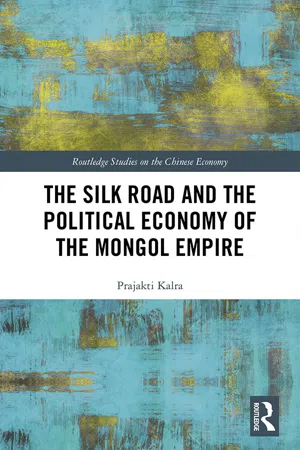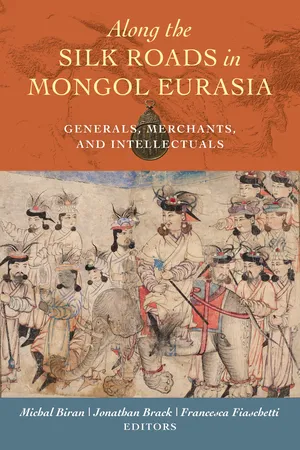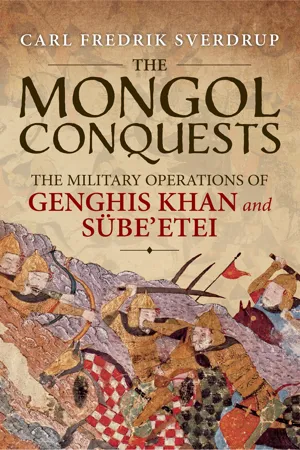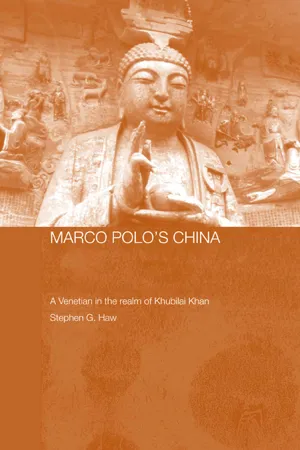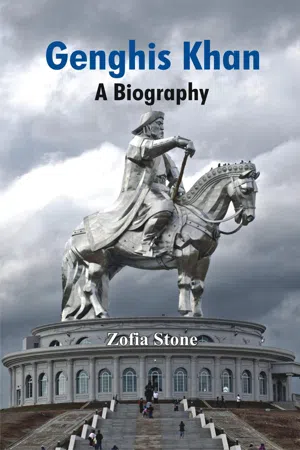History
Genghis Khan
Genghis Khan, born as Temujin, was a Mongol warrior and founder of the Mongol Empire in the 13th century. He is known for his military leadership, strategic brilliance, and the unification of the Mongol tribes. Under his rule, the Mongol Empire became the largest contiguous empire in history, stretching from Eastern Europe to East Asia.
Written by Perlego with AI-assistance
Related key terms
Related key terms
1 of 4
Related key terms
1 of 3
8 Key excerpts on "Genghis Khan"
- eBook - ePub
Truth, History and Politics in Mongolia
Memory of Heroes
- Christopher Kaplonski(Author)
- 2004(Publication Date)
- Routledge(Publisher)
1 POLITICS, MEMORY AND IDENTITY In the thirteenth century, Chinggis Khaan and his immediate successors established the largest contiguous land empire ever. For accomplishing what Napoleon only dreamed of, Chinggis Khaan (more commonly known in the West as Genghis Khan) was rewarded in Europe with such titles as “The Scourge of God” and “World Conqueror.” 1 The Mongolian armies were thought by some to be a punishment sent by God. The medieval Europeans were never quite sure how to react to the Mongols who were rumored to be some sort of fantastic monsters, but could perhaps prove an ally against the infidel Muslims during the Crusades. They defeated the best European military forces of the time, famously affected fish prices in England and Columbus was spurred on by tales of the great wealth of the Mongol rulers of China. 2 The intervening centuries have not been much kinder to the Mongols than the initial impressions in Western eyes. Our perceptions of Chinggis Khaan and the Mongols gives lie to the dictum that history is written by the winners. In this case, our view of the Mongols is shaped by the fact that every time the Mongols encountered Europeans, the Europeans lost, and usually lost badly. A grudging admiration for their military skills is linked to repulsion at the often brutal, but effective, tactics employed. Chinggis Khaan is invoked as the epitome of brutality. If we look to Mongolia itself, the image of Chinggis Khaan changes dramatically. 3 Mongols, of course, are aware of Chinggis Khaan's military campaigns, and take pride in them. Yet in the years immediately after the democratic revolution of 1990, this was not the main focus of interest. In contemporary Mongolian literature and thought, Chinggis Khaan emerges as a far-sighted founder of the Mongolian state, one responsible for bringing law and order to Mongolia. Some go so far as to attribute to him democratic tendencies - eBook - ePub
- Timothy May(Author)
- 2007(Publication Date)
- Pen & Sword Military(Publisher)
Chapter One The rise and expansion of the Mongol Empire, 1185–1265The Mongol Empire founded by Chinggis Khan (also known as Genghis Khan in the West) became the largest contiguous empire in history, stretching from the Sea of Japan to the Mediterranean Sea and the Carpathian Mountains. At its peak, more than a million men were under arms and enrolled in the armies of the Khan, or the emperor of the Mongol Empire. The Mongol Khans became determined to conquer the world, and, indeed, with the resources at their disposal there was little reason why they should fail. Eventually, however, their empire collapsed, partially under its own weight. The following is a brief history of the rise of the Mongol Empire and its subsequent expansion across Asia and into Europe, until it fragmented into four smaller yet still powerful kingdoms.The rise of Chinggis KhanThe most difficult stage in the evolution of the Mongol empire was the unification of Mongolia itself under Chinggis Khan. There was no clear reason why Temüjin, as Chinggis Khan was known, should become the supreme power in the Mongolian steppe. Indeed, there were many more significant leaders and tribes. The Mongols themselves were a broken power, having suffered defeats by their hereditary enemies – the Tatars in eastern Mongolia, and the Jin Dynasty, which ruled Northern China – in the 1160s. The ramifications of these defeats were immense, and resulted in the Mongols declining to the status of a minor power in the steppe, often requiring the support of more powerful tribes to withstand the continued aggression of the Tatars. Nonetheless, although the Mongols were now without a true khan a few clan leaders still maintained the struggle. One such leader was Yisügei Bahadur (bahadur - eBook - ePub
- Dr. Christopher Gabel(Author)
- 2014(Publication Date)
- Tannenberg Publishing(Publisher)
Chapter 2 — Genghis Khan
by Terry Beckenbaugh, Ph.D.Of all the great commanders in human history, perhaps none rose from more dire straits to greater heights than Genghis Khan. Rising from the poverty of exile, the young boy named Temujin who eventually became Genghis Khan, helped his family survive the harsh steppe climate, grew to a strong and charismatic young man who united the disparate Mongol tribes into a nation, and founded what became the world’s largest contiguous land empire. Yet for all his accomplishments, Genghis Khan is probably the least well known of the great commanders. A significant reason for that is the fact that when Genghis Khan founded the Mongol empire, the Mongols had no written language.The earliest primary sources chronicling the Mongols were the accounts of the peoples the Mongols conquered. Since that conquest tended to be brutal, the portrait of the Mongols that emerges is understandably not flattering. To study the Mongols one must have an extraordinary fluency in a variety of foreign languages. Thus, the scholar can spend a lifetime mastering diverse languages such as Japanese, Korean, Chinese, Vietnamese, Turkish, Russian, Persian, Arabic, Hungarian, German, Latin and Mongolian to study the Mongol conquests. An added handicap for people in the English-speaking world who wish to study the Mongols is that the Mongol conquest never reached the British Isles, nor did significant English-speaking elements serve within the Mongol forces or fight against them. This has the effect of tamping down scholarly inquiry in the English-speaking world, so that the English speaker must have reading comprehension of German and/or Russian to read the best western scholarship available on the Mongol empire.{21} Since very few people have the linguistic ability to truly master the plethora of languages necessary to study the Mongols, those who do overwhelmingly tend to focus on a region the Mongols conquered. This narrows the focus to China, Persia, Arabic-speaking lands of the Middle East and Russia and is much more manageable as a scholarly endeavor.{22} - Prajakti Kalra(Author)
- 2018(Publication Date)
- Routledge(Publisher)
1 Rise of Chinggis KhanBy unifying all the Turko-Mongol nations into a single empire, by imposing iron discipline from China to the Caspian, Jenghiz Khan suppressed the endless intertibal wars and afforded the caravansa security they had never known.1The rise of Chinggis Khan (1206–1227) and his empire in the thirteenth century had its roots in the historical, political and social structure of nomadic peoples of Inner Asia. He exemplified adaptation to the changing pattern of steppe society. His policies were a reaction to the anarchy that had descended on the steppe in the eleventh to twelfth centuries as a result of shifting alliances and weak allegiances. His innovative strategies and charismatic personality put him in a position to attract followers and revitalise the region. His polices and reorganisation of the steppe led to its transformation into a place of functional order and stability which was used as a springboard for uniting the rest of Eurasia. The creation of a supratribal identity associated with the person of Chinggis Khan was passed down to his descendants who expanded the Mongol ideology and applied it beyond the steppe. The politics and society in the steppe at the time of Chinggis’ rise presented him with an environment of chaos and dysfunction which was crucial in determining his policies and their appeal to a majority of the tribes. Members of tribes that willingly chose to ally with him initially were dissatisfied individuals who found themselves on the periphery of existent tribes.2 Chinggis Khan himself was an example of a dissatisfied member of a tribe that had left him and his family in their hour of need. His personal life experiences served as a backdrop for the principles which were to guide him in the governance of his empire. The paramount position of stable allegiances and loyalty remained at the centre of the institutions he created and remained the core of the Mongol state even under his descendants. Chinggis Khan’s legal code (yasaq) and the establishment of the imperial bodyguard (keshig) served as the backbone of a Mongol system which valued elements that maintained functional order on the steppe and beyond. He attracted followers as a result of his military successes and his sense of fair play when it came to the distribution of rewards. He exemplified steppe traditions of generosity and reciprocity3 by promising a share in the spoils of war for his army of conquest, returning favours to all the people who helped him in his struggle against his rivals (for example, he offered support to the Khitan brothers in their fight against the Jurchid for their help against his rival Jamugha) and opening trade routes for merchants.4- eBook - ePub
Along the Silk Roads in Mongol Eurasia
Generals, Merchants, and Intellectuals
- Michal Biran, Prof. Dr. Michal Biran(Authors)
- 2020(Publication Date)
- University of California Press(Publisher)
3 these four Mongol polities were centered in China, Iran, Central Asia, and the Volga region, and were headed by contending branches of Chinggis Khan’s descendants. With the dissolution of the United Empire, the Great Khan’s capital shifted from Mongolia to North China, eventually settling in Beijing. Despite the numerous, often bloody, disputes between the four Mongol polities, they retained a strong sense of Chinggisid unity. In the mid-fourteenth century, all four empires were embroiled in political crises that led to the collapse of the Mongol states in Iran (1336) and China (1368), and considerably weakened the two remaining Steppe khanates. The fall of the Great Khan’s state in China is generally considered the end of the “Mongol moment” in world history, although Chinggis Khan’s descendants continued to rule in the western Steppe, Muslim Central Asia, and India, until the eighteenth and nineteenth centuries. Moreover, the memory of the empire and its political structures continued to influence patterns of imperial formation and rule across Eurasia well into the early-modern period.MAP 0.1. Mongol Eurasia (1206–1368) (after Biran 2007, 12–13).THE UNITED MONGOL EMPIRE (YEKE MONGGHOL ULUS , 1206–59)
Most of the empire’s territorial expansion, as well as the formation of its institutions and ideology of world domination, took place during the period of the United Empire. After two decades of bloody internecine wars, Temüjin united the Mongolian tribes and in 1206 was enthroned as Chinggis Khan (literally: universal ruler or harsh ruler). He spent the next few years (1204–9) organizing his nascent state. Relying on the precedents established by the earlier Inner Asian nomadic empires, notably the Turkic Empire of the sixth to eighth centuries, Chinggis Khan borrowed, for the consolidation of his future empire, ideological concepts, a writing system, and military and administrative institutions.Following its incubation period, the newly organized Mongol army had to be put into action soon to prevent its soldiers from turning against each other, provide booty, and maintain Chinggis Khan’s image as a successful military leader. Hence, principally from 1209 onward, Chinggis Khan led his armies outside Mongolia, gradually expanding from raids to conquests. When he died in 1227, he ruled over the largest territory any single individual had ever conquered—from north China to the Caspian Sea. One turning point in his career was his victories in Central Asia, against the Muslim Khwārazmshāh, who in the early thirteenth century ruled a vast, though recently assembled, empire, from Iran to the Jaxartes River (present-day Uzbekistan’s eastern border). Through his military achievements in Central Asia during the 1220s, Chinggis Khan gained both considerable territory and human capital, including highly qualified nomadic warriors. These conquests also added a new set of Muslim precedents and talent to his administrative and imperial toolkit. The extraordinary success of his western campaign convinced Chinggis Khan himself and everyone around him that he was indeed destined to rule the earth.4 - eBook - ePub
The Mongol Conquests
The Military Operations of Genghis Khan and Sube'etei
- Carl Fredrik Sverdrup(Author)
- 2017(Publication Date)
- Helion & Company(Publisher)
4 In this section he will be called Temüjin – covering his own campaigns – and Genghis Khan in the second, where the focus is Sübe’etei. In Chinese annals he is referred to as emperor or specifically the first ruler. They view him as the founder of the Yuan dynasty, though it was only his grandson Kublai who set up court in Beijing.Sources: Zhao Hong, in P. Olbricht and E. Pinks, Meng-Ta Pei-Lu und Hei-ta Shih-Lüeh (Wiesbaden: Harrassowitz, 1980), p.12; Rashid al-Din, 437–440; Juvaini, p.143; George Dennis, Maurice’s Strategikon (Pennsylvania: University of Pennsylvania Press, 1984) p.23; Harold Lamb, The Earth Shakers (Garden City, New York: Doubleday and Company Inc., 1949), p.67; Boyle, commentary on Juvaini, p.55; J. F. C. Fuller, The Generalship of Alexander the Great (New Brunswick: Rutgers University Press), p.58; James Chambers, The Devil’s Horsemen, The Mongol Invasion of Europe (London: Cassell, 1988), p.15; Barfield, p.160; Ratchnevsky, Genghis Khan: His Life and Legacy (Oxford: Blackwell, 1991), pp.17–19; Trevor Royle, A Dictionary of Military Quotations (London: Routledge, 1990), p.55.1 See Zhou Qingshu, ‘A critical examination of the year of birth of Chinggis Khan’, in Xin Luo, Chinese Scholars on Inner Asia (Bloomington, Indiana: Indiana University, 2012), pp.331–352.2 Fuller is retelling a Plutarch anecdote.3 See, for example, in the East Roman manual the Strategikon (written c.AD 620).4 This title is perhaps best rendered into English as Genghis Khan. Genghis Khan is used in this book as this form has become the most recognised.Passage contains an image
2
The Officers
Further, Činggis Qa’an said to Qubilai, ‘For me you pressed down the necks of the mighty ones, the buttocks of the strong ones. You, Qubilai, Jelme, Jebe and Sübe’etei – these “four hounds” of mine – when I sent you off, directing you to the place I had in mind, when I said, “Reach there!”, you crushed the stones to be there; when I said, “Attack!”, you split up the rocks, you shattered the shining stones, you cleft the deep waters. When I sent you, Qubilai, Jelme, Jebe and Sübe’etei, my “four hounds”, to the place I had designated, if Bo’orču, Muqali, Boroqul and Čila’un Ba’atur – these “four steeds” of mine – were at my side, and when the day of battle came and I had Jürčedei and Quyildar standing before me with their Uru’ut and Mangqut troops, then my mind was completely at rest. Qubilai, will you not be in charge of all military affairs?’ - eBook - ePub
Marco Polo's China
A Venetian in the Realm of Khubilai Khan
- Stephen G. Haw(Author)
- 2006(Publication Date)
- Routledge(Publisher)
Chapter 1 ). Under Khubilai, although the government of the Yuan empire had new and distinctive features, it increasingly came to owe a great deal to Chinese precedent.As territory outside Mongolia began to fall under direct Mongol control, it was at first allotted as appanages to Mongol princes, just as steppe lands had been. This was done with much of the former Xi Xia and Jin empires in north China. As already mentioned with reference to the Uighurs, darughachi were usually appointed where it was necessary for settled populations to be controlled and administered. The chief concern of the Mongols was to obtain from the lands and people that they had subjugated as much wealth as they could. They were the conquerors, they were the masters, and they considered it right and fitting that they should enjoy the fullest benefits from the position they had won. It seems that they often had little idea of how to do so, at least in a sustainable way, but there were many among those they conquered who were able to help and advise them. There was probably a complex interplay between the Mongols and the various groups of peoples who came under their rule (De Rachewiltz 1983: 294–5). At least in China, it seems that the Mongol khans experimented with a variety of government methods and made frequent changes to the administrative system before they felt that they had arrived at something that worked well. The appanage system soon began to be abandoned, the tax farming that was much used at first in northern China was replaced, agriculture and commerce were promoted. The traditional Chinese government salt monopoly was reinstated by as early as 1230 (Dawson 1972: 189). Although there were occasional instances of massacres during the Mongol conquest of south China, it was in general a much less bloody affair than the conquest of the Jin empire had been. Khubilai understood that the wealth of the country depended on minimum disturbance of agriculture, commerce and urban life and tried to take over the Southern Song empire as undamaged as possible. Wealthy landowners and merchants were not deprived of their property (Morgan 1986: 120). The unification of China and the opening up of commercial possibilities in other parts of the Mongol empire offered opportunities that had scarcely existed previously. Nevertheless, Khubilai continued to mount costly military expeditions, in addition to spending huge amounts on the construction of the new capital of Dadu and the associated canal projects that enabled it to be supplied with water and with grain and other products from the south (Morgan 1986: 130). The expenditure on all this had, of course, to be provided by income from taxation. - eBook - ePub
Genghis Khan
A Biography
- Zofia Stone(Author)
- 2017(Publication Date)
- Alpha Editions(Publisher)
Timur Lenk (1336-1405), the founder of the Timurid Dynasty, claimed descent from Genghis Khan; however, this claim remains questionable: there is no clear evidence for his own descent; he associated himself with the family of Chagatai Khan through marriage. He also never assumed the title "Khan" for himself, but employed two members of the Chagatai clan as formal heads of state. The Mughal imperial family of the Indian subcontinent descended from Timur through Babur and also from Genghis Khan (through his son Chagatai Khan).The ruling Wang Clan of the Korean Goryeo Dynasty became descendants of the Genghisids through the marriage between King Chungnyeol (reigned 1274-1308) and a daughter of Kublai Khan. All subsequent rulers of Korea for the next 80 years, until King Gongmin, also married Borjigid princesses. But since all Mongol injects were females, no Y-haplotype entered the Korean royal and noble families during this period, only matrilinear mtDNA.At a later period, Tatar potentates of Genghisid stock included the khans of Qazan and Qasim (notably a Russian tsar, Simeon Bekbulatovich, formally Grand Prince of All Rus' from 1575 to 1576, died 1616) and the Giray dynasty, which ruled the Khanate of Crimea until 1783.As the Russian Empire annexed Turkic polities, their Genghizid rulers frequently entered the Russian service. For instance, Kuchum's descendants became Russified as the Tsarevichs of Siberia. Descendants of Ablai Khan assumed in Russia the name of Princes Valikhanov. All these families asserted their Genghisid lineage. The only extant family of this group is the House of Giray, whose members left Soviet Russia for the United States and United Kingdom. Even more a Russian tsar Simeon Bekbulatovich as a grandson of Ahmed Khan bin Küchük was a descendant of Genghis Khan.The Qing of China completely exterminated one branch (Ligdan Khan's descendants) of the Borjigids after an anti-Qing revolt in 1675 by Ejei Khan's brother Abunai and Abunai's son Borni against the Qing. The Qing Emperors then placed the Chahar Mongols under their direct rule.
Index pages curate the most relevant extracts from our library of academic textbooks. They’ve been created using an in-house natural language model (NLM), each adding context and meaning to key research topics.
Explore more topic indexes
Explore more topic indexes
1 of 6
Explore more topic indexes
1 of 4

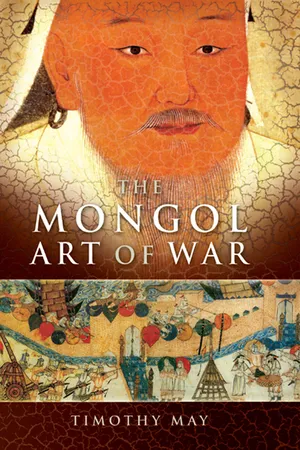
![Great Commanders [Illustrated Edition]](https://img.perlego.com/book-covers/3018137/9781782894469_300_450.webp)
